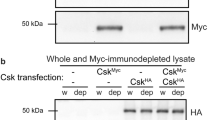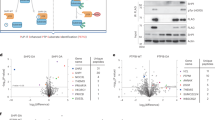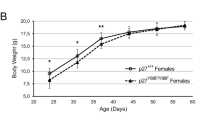Abstract
HePTP is a tyrosine specific protein phosphatase that is strongly expressed in activated T-cells. It was recently demonstrated that in transfected T-cells HePTP impairs TCR-mediated activation of the MAP-kinase family members ERK2 and p38 and it was suggested that both ERK and p38 MAP-kinases are substrates of HePTP. The HePTP gene has been mapped to human chromosome 1q32.1. Abnormalities in this region are frequently found in various hematopoietic malignancies. HePTP is highly expressed in acute myeloid leukemia and its expression in fibroblasts resulted in transformation. To address a possible involvement of HePTP in hematopoietic malignancies we sought to identify HePTP substrate(s) in leukemic cells. Using substrate trapping mutants we have identified the MAP-kinase ERK2 as a specific target of HePTP in the myelogenous leukemia cell line K562. Tyrosine phosphorylated ERK2, but not ERK1, p38, or JNK1, efficiently bound to catalytically inactive HePTP mutants in which the active site cysteine (HePTP-C/S) or the conserved aspartic acid residue (HePTP-D/A) had been exchanged for serine and alanine, respectively. Moreover, the interaction of ERK2 with HePTP trapping mutants was dependent on ERK2 tyrosine phosphorylation, indicating that HePTP is specifically targeted to activated ERK2. Using a deletion mutant of HePTP (HePTP-dLD), in which 14 amino acid residues within the N-terminus are missing, we show that regions outside the catalytic domain are also required for the interaction. Furthermore, overexpression of HePTP in K562 cells and fibroblasts interfered with PMA or growth factor induced MAP-kinase activation and HePTP efficiently dephosphorylated active ERK2 on the tyrosine residue in the activation loop in vitro. Together, these data identify ERK2 as a specific and direct target of HePTP and are consistent with a model in which HePTP negatively regulates ERK2 activity as part of a feedback mechanism.
This is a preview of subscription content, access via your institution
Access options
Subscribe to this journal
Receive 50 print issues and online access
$259.00 per year
only $5.18 per issue
Buy this article
- Purchase on Springer Link
- Instant access to full article PDF
Prices may be subject to local taxes which are calculated during checkout








Similar content being viewed by others
References
Aaronson SA. . 1991 Science 254: 1146–1152.
Adachi M, Sekiya M, Isobe M, Kumura Y, Ogita Z-I, Hinoda Y, Imai K and Yachi A. . 1992 Biochem. Biophys. Res. Comm. 186: 1607–1615.
Adachi M, Sekiya M, Ishino M, Sasaki H, Hinoda Y, Imai K and Yachi A. . 1994 FEBS Lett. 338: 47–52.
Adachi M, Torigoe T, Sekiya M, Minami Y, Taniguchi T, Hinoda Y, Yachi A, Reed JC and Imai K. . 1995 FEBS Lett. 372: 113–118.
Alessi DR, Gomez N, Moorhead G, Lewis T, Keyse SM and Cohen P. . 1995 Current Biol. 5: 283–295.
Bult A, Zhao F, Dirkx R, Raghunathan A, Solimena M and Lombroso PJ. . 1997 Euro. J. Cell Biol. 72: 337–344.
Byon JCH, Kenner KA, Kusari AB and Kusari J. . 1997 P.S.E.B.M. 216: 1–20.
Cobb MH and Goldsmith EJ. . 1995 J. Biol. Chem. 270: 14843–14846.
Fauman EB and Saper MA. . 1996 TIBS 413–417.
Fischer EH, Charbonneau H and Tonks NK. . 1991 Science 253: 401–253.
Flint AJ, Tiganis T, Barford D and Tonks NK. . 1997 Proc. Natl. Acad. Sci. USA 94: 1680–1685.
Gaits F, Li RY, Ragab A, Selves J, Ragab-Thomas JM and Chap H. . 1994 Cell. Mol. Biol. 40: 677–685.
Garton AJ, Flint AJ and Tonks NK. . 1996 Mol. Cell. Biol. 16: 6408–6418.
Gopalbhai K and Meloche S. . 1998 J. Cell. Physiol. 174: 35–47.
Guan KL and Dixon JE. . 1991 Analyt. Biochem. 192: 262–267.
Hendriks W, Schepens J, Burgman C, Zeeuwen P and Wieringa B. . 1995 Biochem. J. 305: 499–504.
Herrera R, Hubbell S, Decker S and Petruzzelli L. . 1998 Exp. Cell Res. 238: 407–414.
Huyer G, Liu S, Kelly J, Moffat J, Payette P, Kennedy B, Tsaprailis G, Gresser MJ and Ramachandran C. . 1997 J. Biol. Chem. 272: 843–851.
Kelly K and Siebenlist U. . 1995 Curr. Opin. Immunol. 7: 327–332.
Keyse SM. . 1995 Biochimica Biophysica Acta 1265: 152–160.
Lewis TS, Shapiro PS and Ahn NG. . 1998 Adv. Cancer Res. 65: 49–139.
Lombroso PJ, Murdoch G and Lerner M. . 1991 Proc. Natl. Acad. Sci. USA 88: 7242–7246.
Mauro LJ and Dixon JE. . 1994 TIBS 19: 151–155.
Mitelman F, Kaneko Y and Trent J. . 1990 Cell Genet. 55: 358–386.
Nagata S and Golstein P. . 1995 Science 267: 1449–1456.
Neel BG and Tonks NK. . 1997 Current Opinion in Cell Biol. 9: 193–204.
Ogata M, Sawada M, Fujino Y and Hamaoko T. . 1995 J. Biol. Chem. 270: 2337–2343.
Patarca R. . 1996 Critical Reviews in Oncogenesis 7: 343–432.
Pulido R, Zu'niga A and Ullrich A. . 1998 EMBO J. 17: 7337–7350.
Qui MS and Green SH. . 1992 Neuron 9: 705–717.
Racke FK, Lewandowska K, Goueli S and Goldfarb AN. . 1997 J. Biol. Chem. 272: 23366–23370.
Radha V, Nambirajan S and Swarup G. . 1997 FEBS Lett. 409: 33–36.
Raingeaud J, Gupta S, Rogers JS, Dickens, Han J, Ulevitch RJ and Davis RJ. . 1995 J. Biol. Chem. 270: 7420–7426.
Rosson D and O'Brien TG. . 1998 Arch. Biochem. Biophys. 352: 298–305.
Saxena M, Williams S, Gilman J and Mustelin T. . 1998 J. Biol. Chem. 273: 15340–15344.
Saxena M, Williams S, Brockdorff J, Gilman J and Mustelin T. . 1999 J. Biol. Chem. 274: 11693–11700.
Seger R and Krebs EG. . 1995 FASEB J. 9: 726–735.
Sharma E, Zhao F, Bult A and Lombroso PJ. . 1995 Mol. Brain Res. 32: 87–93.
Shiozuka K, Watanabe Y, Ikeda T, Hashimoto S and Kawashima H. . 1995 Gene 162: 279–284.
Takekawa M, Itoh F, Hinoda Y, Adachi M, Ariyama T, Inazawa J, Imai K and Yachi A. . 1994 FEBS Lett. 339: 222–228.
Traverse S, Gomez N, Paterson H, Marshall C and Cohen P. . 1992 Biochem. J. 288: 351–355.
Urushibara N, Karasaki H, Nakamura K, Mizuno Y, Ogawa K and Kikuchi K. . 1998 Int. J. Onc. 12: 603–607.
van den Brink MRM, Kapeller R, Pratt CJ, Chang J-H and Burakoff SJ. . 1999 J. Biol. Sci. 274: 11178–11185.
van Huijsduijnen RH. . 1998 Gene 225: 1–8.
Whalen AM, Galasinski SC, Shapiro PS, Stines Nahreini T and Ahn NG. . 1997 Mol. Cell. Biol. 17: 1947–1958.
Zanke B, Suzuki H, Kishihara K, Minden M, Pawson A and Mak TW. . 1992 Eur. J. Immunol. 22: 235–239.
Zanke B, Squire J, Griesser H, Henry M, Suzuki H, Patterson B, Minden M and Mak TW. . 1994 Leukemia 8: 236–244.
Zhang ZY. . 1998 Critical Reviews in Biochem. and Mol. Biol. 33: 1–52.
Acknowledgements
We would like to thank Terrill K McClanahan and Karin Franz-Bacon for generation of the Th1 cDNA library. We thank Debra Liggett for oligo synthesis and the DNAX sequencing group for their assistance. We are grateful to Stuart Tangye, Mike Bigler, Martin McMahon, James Johnston, Alyssa Morimoto and Emma Lees for providing cell lines. We thank Emma Lees, Jing Wang, Alyssa Morimoto, Sarah Pogue, Greg Fujii, Mike Tomlinson, and Jim Johnston for helpful suggestions and critically reading the manuscript. We also thank Gary Burget and Maribel Andonian for graphics support. DNAX Research Institute is fully supported by Schering-Plough Corporation.
Author information
Authors and Affiliations
Rights and permissions
About this article
Cite this article
Pettiford, S., Herbst, R. The MAP-kinase ERK2 is a specific substrate of the protein tyrosine phosphatase HePTP. Oncogene 19, 858–869 (2000). https://doi.org/10.1038/sj.onc.1203408
Received:
Revised:
Accepted:
Published:
Issue Date:
DOI: https://doi.org/10.1038/sj.onc.1203408



